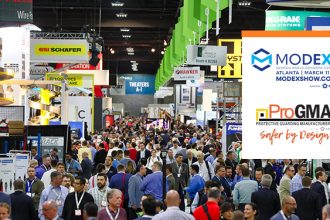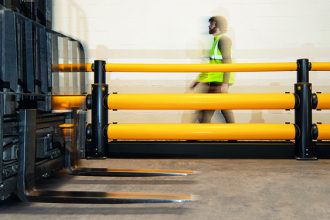Ground-Level Protective Curbs Stop Forklift Penetration Damage

As forklifts move around a facility — either with or without a load — their forks are typically raised 2 or 3 inches above the floor. This gives the operator a less obstructed view of the route ahead; however, the forks themselves could still accidentally make contact with equipment or structures, such as workstations, conveyor supports, walls or columns. There is also a chance that forks could pass under guardrails and other protective barriers, encroaching into walkways or pedestrian zones and causing injury to an associate. To prevent such incidents, protective curbs up to a height of 8 inches can be installed at floor level.
Such protective curbs are usually constructed of polymer materials or steel and are generally bolted to into the floor from the top for maximum impact resistance. Steel will resist an impact; however, it will permanently deform. Any energy that is not absorbed by this deformation will be transferred into the fixings and the floor. Conversely, polymer protective curbs are designed to absorb and dissipate impact energy by flexing and returning to their original shape.
Curbs used in combination with new guardrails are typically installed at the same time as the rest of the solution. Alternately, it is possible to add them later as a retrofit solution to an existing guardrail installation. For maximum visibility, protective curbs are colored — usually yellow — to contrast with their environment. They are either painted, in the case of steel, or self-colored in the case of polymer.
When specifying protective curbs for a facility, share the following information with potential suppliers:
- The width of the space to be protected. Depending on the span, multiple curbs may need to be installed and joined together.
- If the intent is to install a curb in front of equipment or another structure, the available space in the installation area. The curb will need to be set away from the object to absorb an impact without making secondary contact as it deforms.
- The maximum speed of the vehicles used in that area.
- The environment in which the curbs will be installed (ambient-temperature, cold storage, freezer), which may affect the type of material used.
- The type of material required, as protective curbs can be constructed of steel or polymer.
- The condition of the floor and its ability to support a curb being bolted into it.
Want more details about installing protective curbs and other barriers in your facility? The members of the Protective Guarding Manufacturers Association (ProGMA) are available for guidance and recommendations.



